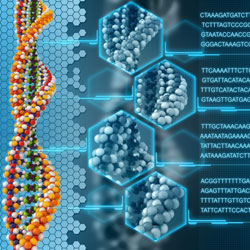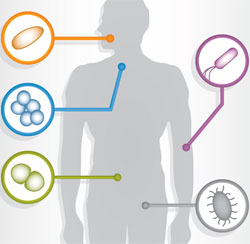Bioinformatics: The Key to a Precision Medicine Future
 In October 2016, international experts in biomedicine convened to launch the Human Cell Atlas, an effort to “chart the types and properties of all human cells, across all tissues and organs, to build a reference map of the healthy body”. According to the collaborators, such a map would lay the groundwork for understanding not only healthy human development, but also the perturbations that cause disease, and pave the way for novel diagnostics and treatments for subpopulations and individuals.
In October 2016, international experts in biomedicine convened to launch the Human Cell Atlas, an effort to “chart the types and properties of all human cells, across all tissues and organs, to build a reference map of the healthy body”. According to the collaborators, such a map would lay the groundwork for understanding not only healthy human development, but also the perturbations that cause disease, and pave the way for novel diagnostics and treatments for subpopulations and individuals.
In an article supporting the initiative, Creating a Census of Human Cells, systems biologist Aviv Regev of the Broad Institute states that “sampling algorithms and Big Data computational techniques that enable creation of an overall cell census” will be integral to the success of the project. In other words, bioinformatics technologies are key.
A similar theme emerged a couple of years ago, with the launch of the US National Institutes of Health’s Precision Medicine Initiative, which aims to “leverage advances in genomics, emerging methods for managing and analyzing large data sets while protecting privacy, and health information technology to accelerate biomedical discoveries.”
Pharma has invested heavily in data-producing technologies such as next-generation and single cell sequencing, but has been slower to make big investments in the data management and data analytics technologies that can make sense of all that input.
Yet where those investments have been made, progress is being made, as well. Consider recent advances in:
 Understanding rare diseases. An estimated 350 million people worldwide suffer from one of 7,000 rare diseases. Currently, there is no approved drug treatment for 95 percent of these diseases – but bioinformatics tools are changing that picture.
Understanding rare diseases. An estimated 350 million people worldwide suffer from one of 7,000 rare diseases. Currently, there is no approved drug treatment for 95 percent of these diseases – but bioinformatics tools are changing that picture.
Drug repurposing is a relatively fast and safe way to identify drugs that have already met pharmacovigilance and regulatory requirements, and are therefore poised for approval for a new indication for a rare disease. Bioinformatics tools give research and development professionals the ability to rapidly mine data from the literature, regulatory documents, clinical trials and other patient-centric information to more quickly target an existing drug to a specific rare disease population, and also to identify other promising repurposing candidates.
For example, the UK nonprofit Findacure aims to save the National Health Service money by identifying potentially repurposable off-patent drugs to treat rare diseases. Elsevier is donating bioinformatics tools and expertise to help in the nonprofit’s first proof-of-concept effort – the development of an evidence base to support the launch of a clinical trial that will test the efficacy of the immunosuppressant sirolimus for children with congenital hyperinsulinism.
On a larger scale, dozens of institutions are partnering with RD-Connect, a global effort to share, standardize and analyze data from biobanks and registries to facilitate the discovery of diagnostic tools and therapies for rare diseases. The initiative also intends to develop bioinformatics tools to facilitate data sharing and analysis, as well as cohort selection for clinical trials.
 Accelerating immunotherapy development. Developing targeted, personalized immunotherapies demands a cellular-level understanding of specific immune cells. However, identifying all the relevant data in the scientific literature is difficult because different laboratories may use different nomenclature when referring to the same proteins and processes.
Accelerating immunotherapy development. Developing targeted, personalized immunotherapies demands a cellular-level understanding of specific immune cells. However, identifying all the relevant data in the scientific literature is difficult because different laboratories may use different nomenclature when referring to the same proteins and processes.
For example, Carnegie Mellon researchers recently undertook a DARPA (Defense Advanced Research Projects Agency) project that involved creating a summary of “core knowledge” about KRAS (protein coding gene) signaling pathways to help with the development of new disease models for cancer. They discovered that the gene of interest alone might be referred to as KRAS, KRAS2 or RASK2, according to UniProt, and its protein may be referred to as GTPase Kras; K-Ras 2; Ki-Ras; c-K-ras; or c-Ki-ras. Moreover, KRAS interacts with about 150 other proteins in the human genome, all of which are likely to have multiple synonyms.
Natural language processing software, another bioinformatics tool, helped to standardize the nomenclature, facilitating the understanding of both terminology and, when available, experimental methods. The software and a consultant with domain expertise together enabled “deep reading” of the literature – i.e., the machines could “read” articles more like scientists do, making judgments about statements and findings, and extracting only information that validated or contributed to existing knowledge about KRAS.
 Improving microbiome analyses. The emerging field of microbiome analysis holds promise for personalized medicine, but for now raises more questions than it answers. A recent blog on the website of the American Microbiome Institute underscores the wide variation that currently exists in microbiome sequencing and analysis, and a recent paper in Science explores the difficulty of establishing just what constitutes a “normal” gut microbiome.
Improving microbiome analyses. The emerging field of microbiome analysis holds promise for personalized medicine, but for now raises more questions than it answers. A recent blog on the website of the American Microbiome Institute underscores the wide variation that currently exists in microbiome sequencing and analysis, and a recent paper in Science explores the difficulty of establishing just what constitutes a “normal” gut microbiome.
These large knowledge gaps didn’t stop at least two companies from offering gut analyses to consumers – and coming up with completely conflicting results.
Simply put, for now, personal microbiome analyses have huge margins of error. Filtering out the “noise” with bioinformatics tools is essential for making such analyses usable in research and development and, ultimately, beneficial for patients.
Efforts are underway to enable microbiome to fulfill its promise. The Microbiome Quality Control Project is a multicenter initiative to evaluate and standardize methods for assessing the human microbiome and its role in health and disease. Elsevier recently launched the open access Human Microbiome Journal, which will help chart progress in this area by making high quality research freely available.
What’s ahead?
 A relatively new field, translational bioinformatics, is poised to become an important discipline for precision medicine. Defined by the American Medical Informatics Association as “the development of storage, analytic, and interpretive methods to optimize the transformation of increasingly voluminous biomedical data, and genomic data, into proactive, predictive, preventive, and participatory health” translational bioinformatics is at the forefront of data-driven health care.
A relatively new field, translational bioinformatics, is poised to become an important discipline for precision medicine. Defined by the American Medical Informatics Association as “the development of storage, analytic, and interpretive methods to optimize the transformation of increasingly voluminous biomedical data, and genomic data, into proactive, predictive, preventive, and participatory health” translational bioinformatics is at the forefront of data-driven health care.
To realize the full power of translational bioinformatics and generate actionable results for populations and individuals, more professionals who know how to use those tools, and accurately interpret the findings, are needed.
As Joel Dudley of the Icahn School of Medicine at Mount Sinai, New York City, stated in a recent publication, “An important bottleneck in the application of bioinformatics methods in translational research is the lack of investigators who are versed in both biomedical domains and informatics. Efforts to nurture both sets of competencies within individuals and to increase interfield visibility will help to accelerate the adoption and increased application of bioinformatics in translational research.”
yogaesoteric
April 5, 2017
